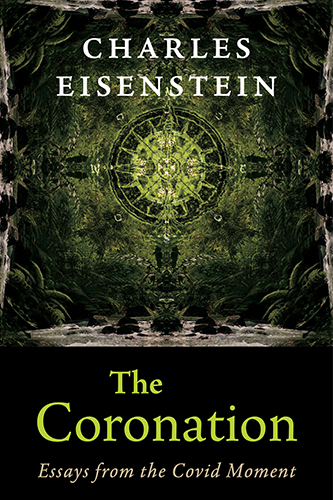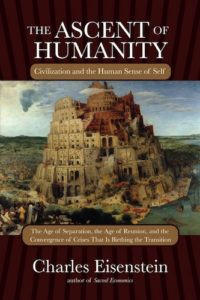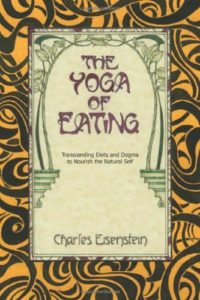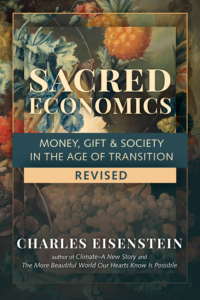The Ascent of Humanity
Chapters
Chapter 7: The Age of Reunion
In Love with the World
The last section describes how an emerging language of truth will transform the human drama from an unconsciously scripted tragicomedy into a conscious play, a great work of the story-teller’s art. Through language, humanity will become a conscious agent of the universe’s unfolding. Pruned of the tangle of excess verbiage that obscures meaning, representational language will be a richer and more meaningful realm than what we have today. Nonetheless, in many important areas of life, language and especially written language will play a reduced role. That is because like reason, like linear technology, like money, the gift of language has exceeded its proper domain. We use words to express many things that words are fundamentally incapable of expressing, and most words express nothing at all.
There are signs that the shrinkage of the domain of language that will accompany the Age of Reunion is already beginning to happen. It is a response, I think, to the “crisis of language” I wrote about in Chapter Two, in which words seem to mean less and less, “forcing us into increasingly exaggerated elocutions to communicate at all”; in which advertising has become ubiquitous and wholly insincere; in which politicians lie routinely and get away with it, and in which we discount nearly all public speech as PR, spin, and hype. Living in a ubiquitous matrix of lies, we naturally respond by discounting all speech. Because of its ubiquity (especially of the printed word), we tune it out; because of its insincerity we discount it and second-guess it.
Faced with this crisis, young people in particular are drifting toward other ways of communicating. This may be one of the deep reasons behind the astonishing decline in literacy over the past generation. Ask a retiring college professor about it! When I began teaching at Penn State a few years ago I was shocked to discover that many of my students could not read. They could scan through a page and pull out answers, but they were seemingly incapable of integrating ideas over an entire paragraph; nor could they write coherently. Compared to the standards of a hundred years ago, Americans are shockingly illiterate. Yet we are no less intelligent and no less hungry for communication. To an extent, declining literacy represents another robbery of our spiritual capital, the sell-off of yet another cognitive capacity, but another major could be a semi-conscious moral repugnance at the inanity and inauthenticity of the words that inundate us today.
Fed up with the lies, young people in particular turn increasingly to music and other modes of non-textual expression. I think I see the beginning of a trend. One sign is the exploding popularity of websites such as MySpace, Facebook, and Youtube, where, thanks to technology, people share, in addition to words, photographs, music, voice, and video. Meanwhile, the established commercial interests are fighting a desperate battle against the democratization of music production and distribution that technology has made possible. Almost anyone can produce, record, and distribute music (and video) at minimal cost. The technological infrastructure is in place for a return to the gift economy, and only awaits the demise of the extractive, centralizing interest-based financial system we have now. The dominance of text in remote communication may be coming to an end—a momentous development, for it could signal the end of an era that started with the printing press some five centuries ago. Of course there are functions for which text is uniquely suited, and books will surely survive in one form or another. But the written word’s monopoly on public and long-distance communication, eroding ever since the age of radio, is coming to an end. Words will reign in a more circumscribed realm. On the Web, podcasts and video streaming may soon eclipse words as the dominant media of communication. Already a lot of people prefer audio books over the written versions. Video-capable cellphones have replaced letter writing, nearly a lost art. I wonder if real literacy will retreat to the three percent or so of the population it comprised in pre-modern times?
Whether or not it is mediated by technology, could we be initiating a halting return to the lingua adamica of old? Or will the regime of separation continue to new extremes, a VR world of avatars and voice simulators where nothing is real? I envision a future in which we return to the voice, the song, and the face in communication. The Piraha, whose communication is mostly singing and humming, show us the future as well as the past. At least, they show us a future possibility. I may be wrong, after all; maybe the Age of Reunion will never come, not in our lifetimes, not in a thousand years. Or perhaps both worlds will coexist, and we as individuals shall choose which we live in. In any event, the most important dimension of a return to unmediated communication is direct and personal. There are signs of this as well, transformational technologies such as Authentic Movement, Contact Improv, and the ContinuumTM that help people reclaim some of the vocabulary of the Original Language of body and voice. I encourage you to try them out. An actual experience of the intimacy of communication that is possible without words will be far more effective than this book in persuading you that an Age of Reunion is possible, imminent, right there in front of us. Only our fears, habits, and beliefs keep it hidden.
The lingua adamica, the mythic Original Language of humankind, admits no lying and no separation between subject and object. There is no need to infer as to the state of being of the utterer, for her vocalizations are facets of that state. To understand the real voice of another person requires and furthers an intimacy so profound as to dissolve the boundaries between self and other; these days such intimacy typically exists only between mother and infant, sometimes between father and infant, and on occasion between the most trusting of lovers in special moments. I believe that in former times, before the Age of Separation was much underway, such intimacy was the rule in the human relationships of the Stone Age kin band. Language as we know it today was unnecessary. Reports, some by respected anthropologists, abound that describe aboriginal communication abilities that border on the telepathic. Such communication was not limited to human relationships, for people of those times enjoyed a profound intimacy with nature that, by many accounts, allowed them to understand the languages of animals, plants, forests, wind and clouds.
These languages are so unlike the abstract systems of signs that constitute language today that we probably shouldn’t even call them by that name. Today’s languages are a corruption, a degeneration, at times an imitation but usually an obfuscation of the original lingua adamica. To communicate in the Original Language involves a temporary fusion of self and other; it is to be the other that is speaking, to understand that other so deeply that its essence is displayed nakedly in its sounds, odors, and motions. It is as impossible to lie in the lingua adamica as it is to fake an odor. We can hide it, mask it, or suppress it, but it is always there underneath.
When we bare our true voice to another and really hear the voice behind the words, boundaries dissolve into an unutterably sweet intimacy. This requires total trust, which is impossible when we see the world as competing others, and so happens very rarely today. In the Age of Reunion we will grow gradually less attached to these boundaries. We will be unafraid to relinquish them at will, so that we can live in a profound richness of relationship. To a person living in such intimacy with other people and all Others, life is suffused at every moment with a depth of meaning that we can hardly imagine today. To simply sit and do nothing can be an overwhelmingly sensuous experience. The bliss of such a state is so intense there is hardly reason to do anything but just be. Language or any kind of conceptualization removes us from this state and deprives the world of meaning. (Yet is there a possibility of being simultaneously attuned to both, to word and to voice? Why have we embarked upon the sojourn of separation that began with language?)
The longing for that state of bliss, buried deeply within all of us, drives us never to be satisfied with the lesser world of separation we have created. I know this because I have had the fortune to experience the lingua adamica, though just a few times in fullness. Separated by a telephone wire, I and this other merged so completely through voice that there was no distinction between I and thou. In every sound, her total being was manifest to me, and mine to her. Language is utterly insufficient to convey the intensity of this union: words like “mine” and “her” imply a separation that did not exist.
A Homecoming awaits beneath our names, our numbers, our words, and our physical separation; you have been waiting for it your whole life. Sometimes it wells up and we run before it to save our selves, but its trace remains as a promise and a reminder of what life should, can, and will be.
Communication in the lingua adamica is an occasion of profound intimacy between the communicants, and it is absolutely specific to them. There are as many Original Languages as there are pairs of communicants. To a third party not sharing their intimacy, the lingua adamicawould have no more meaning than so many birdsongs—only the grossest emotional states would be apparent.[51] To the intimate, however, a single noise communicates an infinity of nuance. Not only are no two lingua adamicas the same, but no two words are ever the same between two people. Each communication is unique, just as each moment is unique. There is no reduction of the infinitude of experience. Speaking the Original Language is much like making love, and indeed it is no coincidence that the vocalizations of sexual passion are among the few out-breakings of the lingua adamica in modern adults. But someday we will be in love with the world.
A trace of the lingua adamica can be found in poetry and music. Poets and poetically-inclined prose writers know that “the melodic structure precedes and partly determines the structure of the text in poetry.”[52] We can only imagine what poetry would be without words—it would be a song, a ululation of non-referential sounds nonetheless laden with meaning, perhaps akin to the spontaneous scatting of jazz vocalists or the spirit songs gifted to Native American vision questers. Spontaneity is a key feature of this sort of communication. It is not a colonization of the other, not an imposition of one’s own categories, not a reduction of the world into a finite collection of labels. According to Joseph Epes Brown, Native Americans insist that the songs used in their ceremonies are never composed, but are rather given by spirits.[53]
The lingua adamica is not only our distant heritage but also our birthright and our future. The process by which it is learned is wholly different from that of learning any other language. Whereas a language of symbols necessarily involves an equating of A to B and thus a separation and alienation, the lingua adamica embodies the uniqueness of each A and B, each part of the whole and each moment in time, and it requires a coming together, not a separation. To learn the lingua adamica requires a dropping of the artificial boundaries that keep us apart, a dropping of the conventions of me and mine. To speak it with another means falling in love with that other to the point where it is no longer an other.[54] The more intimate and trusting the love, the more liberty to let down the barriers of self, the more highly developed the understanding of the mutual lingua adamica and the less necessary ordinary words become.
If to speak the lingua adamica with another is to fall in love with that other, then to understand the languages of plants, animals, and inorganic processes requires nothing less than to fall in love with the world. The lingua adamica emerges with the melting of barriers between self and world. As the futility, artificiality, and factitiousness of these barriers becomes increasingly apparent with the breakdown of modern society, we will find ourselves speaking less and coming naturally into our birthright.
To learn the language of the world—what a beautiful and fruitful definition of science that would be! Science, to learn the language of the world so as to fall more deeply in love with it. How different that is from the mentality of mastery and control, from the Baconian inquisition of nature. It begins with the awe of the scientist apprehending the cell, the stars, the complexity of an ecosystem or a metabolism, the miracle of life. It is a return to the presence of the divine in nature. It is the culmination of the journey of science, which chopped nature up into pieces, isolated it and refined it, purified it and reduced it, only to discover at every turn unsuspected new realms of beauty, wonder, and miracles.
The loss of the particular that comes with the generic categorizations of label and number is a cause and a symptom of our falling out of love with the world. Conversely, when we fall in love we see our beloved as a real, unique individual, irreplaceable. The Age of Reunion is nothing more or less than a falling back in love with the world. Nothing, not even an electron, is generic. All are unique individuals, special, and therefore sacred. In physics the quest of four centuries to reduce complex reality to universal laws acting on generic fundamental particles is collapsing, as the variety of “fundamental” particles multiplies, as known physical forces stubbornly resist unification, and as we digest the fact of indeterminacy. Even an electron has an irreducible individuality, an unpredictability to its behavior that is not merely an illusory consequence of our ignorance of more minute causes. Not enslaved to cause, it is an autonomous Chooser. As with the electron, so with the proton, the neutron, and everything made of them. Moreover, this individuality is not a separately existent property, but only intelligible in relation to the rest of the universe. In particle physics we see it in the phenomenon of a “measurement”, which is really just relationship manifest; in biology we see it in the web of relationships that define and sustain any organism. In human psychology, the same principle accords us a status as absolutely unique individuals, whose individuality is an infinite set of relationships to the rest of the world.
When we fall in love with the world, we will perceive and treat everything as sacred. Conventional religion sees some things as sacred and others as mundane, inert and interchangeable masses. To be sacred is to be imbued with a specialness, uniqueness, and divine purpose. To see something that way is to fall in love.
The Age of Reunion is a return to the Original Religion of animism. No longer will we divide the universe into the sacred and the profane, the spiritual and the mundane. Everything will be sacred because we know that everything is unique, even each electron, each drop of water, and certainly each human being. We know this already, of course. We have known it for a long time, but relegated it to the realm of Mr. Roger’s Neighborhood (“You are special”) or half-understood lines of scripture, as we continue to label and judge people and groups of people. Let us imagine a world where it is the basis of life. It is coming, the more beautiful world predicted in so many myths. A world alive with spirit, and a spirituality alive in the world. The core message of New Age spirituality is, “You are divine.” From Deepak Chopra to the Gospel of Thomas, from Louise Hay to the Bhagavad Gita, the teaching of the indwelling divinity of all things foretells the spirituality of the Age of Reunion. Instead of spurning the material world for higher things, it loves and embraces the material world and treats all as sacred.
In holistic medicine we will love our patients. Holistic economics will grow from love of people and their work (“each job will be unique”), and holistic science will love the processes of the universe itself. All along, that has been our innate yearning, simply to love and be loved. We feel its stirrings but fear to act on them, so enslaved are we to survival anxiety and the logic of the machine. The former is the feeling of not being able to “afford to” act from our humanity, and we respond to it with the program of control. The latter is the categorization of every person or object as a generic example of one or another type, to be addressed through the professional, dispassionate, and objective application of method.
The convergence of crises will lay bare the fraudulence of the logic of the machine as well as the futility of the program of control. No longer will fear or ideology keep us from falling back in love with the world. As a result, all the old dualisms will crumble. There will be no distinction between a personal relationship and an economic relationship: economic relationships will be personal. There will be no distinction between work and play: all work will be playful. There will be no distinction between science and religion: both will lead us to love the world and to understand more fully our role in the unfolding cosmic pattern. There will be no distinction between work and art: both will seek to participate in the creation of beauty.
All of this, and more, will spring from the dissolution of the greatest dualism of them all, that between self and other. That is not to say we will all merge into undifferentiated oneness—nature is not like that, and neither are we. The discrete and separate self will not disappear but will become more fluid, more playful, no longer a permanent, irrevocable feature of our reality. We will feel and define our individuality through relationships to everything else; no longer will we think in terms of having relationships, but in terms of being relationships. As our relationships change and grow, so will we, thereby participating in and contributing to the growth of the whole.
A psychic once told me of a vision of the “million years of dreaming” that is to follow the collapse of the present world. In a dream, the world is malleable to the mind’s reshaping, and the distinction between subject and object fluid. One interpretation would be the fulfillment of the Technological Program in which nano-technology makes reality malleable to our every whim. But maybe the vision means something quite different. In a dream, the fluidity of perspective allows us to “be” first one character, then another, then to see it all from the outside, then to be the entire dream, which after all is (supposedly) all in our head. The million years of dreaming is not the imposition of our dreams of domination onto reality, but our participation in the universe’s dreaming of itself. In love, we identify with another, see and feel the world from its perspective, and so realize our essential unity. So also in a dream. By falling back in love with the world, we enter the cosmic dream, and in releasing our discrete and separate selves, grow into who we are.
[51] Of course, birdsongs have far more meaning than most of us realize, and indeed are part of the Original Language of Nature. The metaphor refers to the modern listener.
[52] Fonágy, Ivan, Languages within Language, John Benjamins Publishing, 2001. p. 181
[53] Brown, Joseph Epes, Teaching Spirits, Oxford University Press, 2001. p. 35
[54] The forced, contrived, premature opening of boundaries in the absence of love does not bring one any closer to the lingua adamica, but only invites violation.






